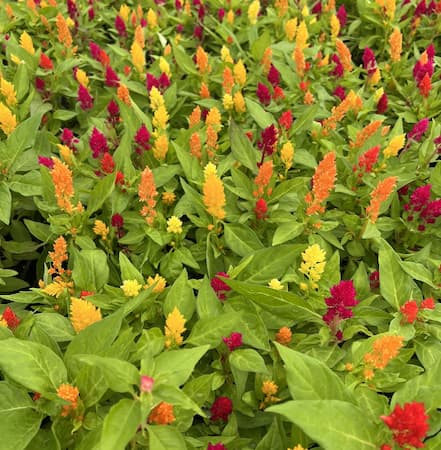How to Grow Celosia Flowers

Growing Annual Celosia Flowers in Your Flower Garden
If you are looking for a flower to brighten up a flowerbed, then growing Celosia is for you. Annual Celosia flowers are noted for their brilliant “rooster comb” plumes. Hence, it should not come as a surprise to learn that this flower is also called “Cockscomb”. The flowers bloom over a long period of time, up to three months. Celosia makes a very showy, unusual display in borders and as edging. Smaller varieties also look good in flowerpots on your patio or deck, or in windowsills. Importantly, the seeds are very fine. Consequently, heavy rains can wash the tiny seeds out of the soil, or too deeply into it. Indoor plant starts may prove more successful.
Celosia is wonderful for bouquets, fresh or dried. To dry these flowers, hang them upside down in a cool dark, and dry place, for about two months.
Celosia Flowers Plant Specifications
Flower Colors: The brilliant reds are by far the most popular color. Other colors include yellow, orange, crimson, rose, and purple flowers.
Flowers Bloom: Summer through Fall.
Plant Height: Up to 30 inches.
Light Requirements: Full sun to partial sun.
Ideal Soil pH: 6.0 – 7.0.
Hardiness Zone: 3 – 11. This adaptable plant grows well in most hardiness zones.
Toxicity: Non-toxic.
Native To: Africa, North and South America.
Plant Type: Annual
Botanical Name: Celosia Cristata
Other Names: Celosia is also called Cockscomb, Lagos Spinach, Quail Grass, and Woolflowers.
Are Celosia Plants Edible?
YES!! The flowers, young tender leaves, and stems are all edible.
Eat them like any vegetable. Boil, steam, or stir-fry the plants. Include them in soups and stews. Mix them into mashed potatoes, rice, or couscous.
Medicinal Uses for Annual Celosia Flowers
There are many medicinal uses for Cockscomb plants. Among them are:
- Juices from the flowers and leaves are used to create a body wash to treat wounds and a variety of skin ailments.
- it is eaten for dysentery.
- Use the flowers and leaves to relieve menstrual problems.
Important Note: A side effect of using Celosia medicinally is that it dilates the pupil. People with glaucoma should not use it. If you have other eye afflictions, consult your optometrist before using andy Celosia-based medicine.
Light Requirements
Grow the plants under full sunlight. Give them six to eight hours of full sun. Too little light results in lanky plants and can reduce flower blooms.
Celosia Flowers Propagation
Celosia, or Cockscomb, flowers are grown from very fine seeds. They can be directly seeded into your flower garden or seeded indoors for transplanting later. If planting outdoors, sow Celosia seeds after the soil has begun to warm in the spring. Also, we recommend starting them indoors 4-6 weeks before the last frost date for your area. Seeds need to stay moist and require warm soil to germinate.
Sow seeds early in the season and cover lightly with 1/8″ of fine soil. Water thoroughly and keep the soil moist.
They can also be propagated by plant cuttings.
Days to Germination: 10-15 days.
How to Grow Celosia Flowers
Celosia plants like full sun. They need rich soil with lots of compost to produce big, brilliant plumes. The soil needs to be moist, not wet. Water them during dry periods regularly. The plants do not like soggy soil. Soil should drain well.
Add a general-purpose fertilizer once or twice a month. In flowerpots, use a liquid fertilizer every two to three weeks.
Space small varieties about 18″ apart and larger varieties 18″-24″ apart. Smaller varieties will grow 10″-12″. Larger types will grow up to three feet.
Tip: To produce more plumes, pinch back the first one. While you may be anxious for those first bright blooms, this will promote more branching and reward you later.
Mulch around the plants to provide a neat and tidy appearance.
The taller varieties may need staking.
Pruning Celosia Plants
Usually, these annuals do not need pruning. When the plants reach six inches tall, pinch back the growing tips of the stems to create more stems and bushier plants. Remove any dead, or diseased leaves.
Deadheading spent flower blooms helps to promote new buds to form. And, it prolongs the blooming period.
More on Deadheading Plants.
Insects and Plant Disease
Celosia flowers are somewhat resistant to insects and disease. Occasionally, aphids enjoy the leaves and stems. But, if insect or disease problems occur, treat problems early with organic or chemical insect repellents and fungicides.
Also see: Plant Problems – causes and cures.
Related Articles
People who read this article will also like:
How to Grow Celosia Plants – by Garden Hobbies
Please support our site. Shop for:
- rmmatthews100@hotmail.com
- 585-721-6528
- Rochester, NY
©1999-2024 GardenersNet.Com, All Rights Reserved

